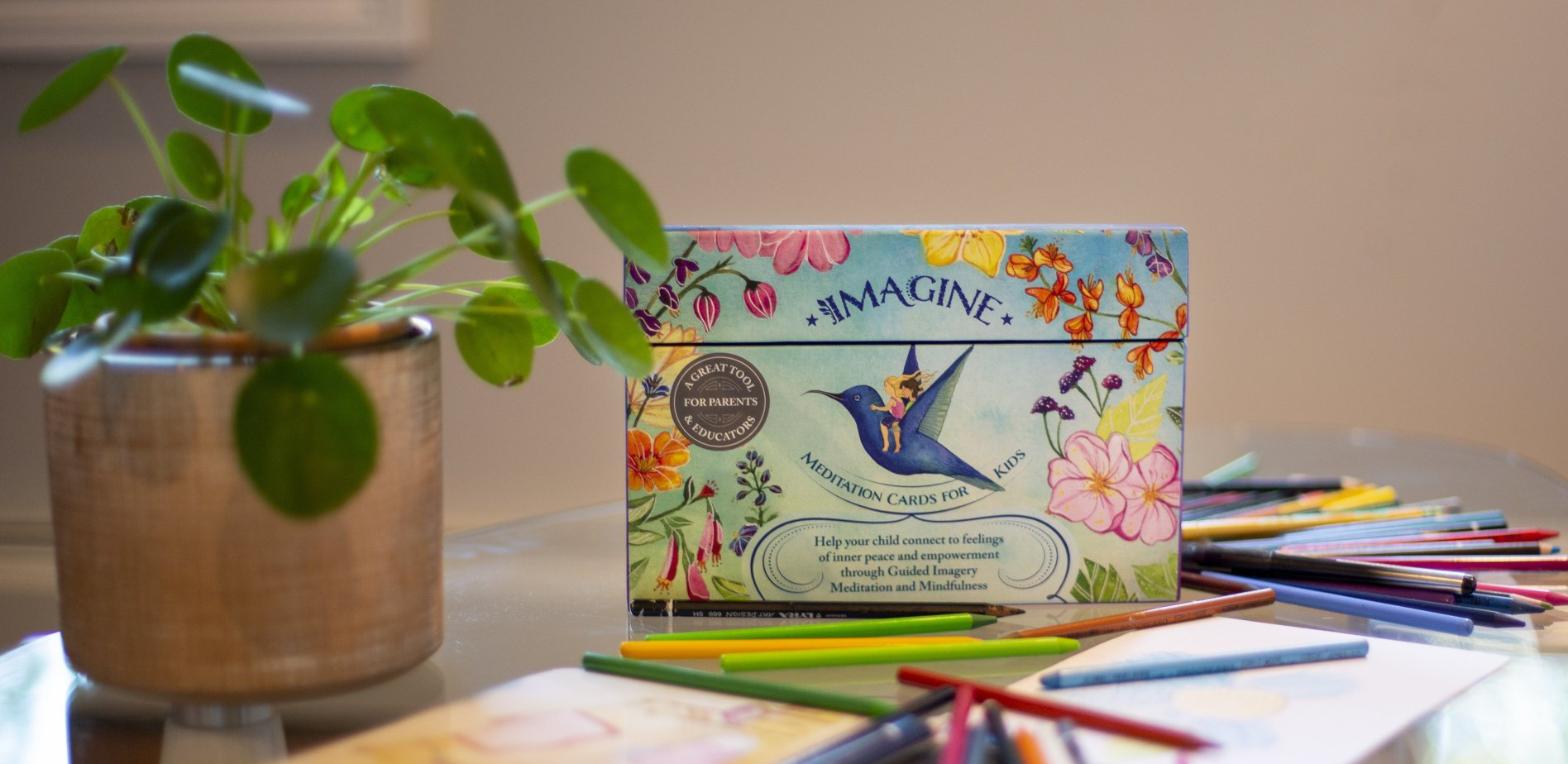Meditating with Restless Kids (Yes, It’s Possible)
Meirav Tamir • June 12, 2020
For many people, the words “meditation” and “kids” seem mutually exclusive. It’s just a bit challenging to imagine an energetic child staying quiet for any significant amount of time
without using an electronic screen of some sort or actually being asleep.
It’s also hard to come up with a good way to convince kids that closing their eyes and not thinking about anything could be a really cool idea… We already know that focusing on our breathing for a few moments can be very healthful, but how do we “sell” this idea to kids?
We could ready ourselves for a good parenting/educational discussion in which we raise the list of benefits
linked to meditating and talk about all the pros until we’re blue in the face.
Still, getting kids to really give it a full-hearted try – not necessarily as simple as ABC, is it?
So what can we do to help make this a smooth-sailing experience? It begins with releasing expectations of any sort.
This is true for any meditation, and for any person meditating, whether they be a kid or an adult.
If we begin our meditative experience with the expectation or assumption that it will go a certain way, the moment it slips from the route we envisioned, we may begin to feel as though our effort was ruined or wasted.
Deciding to go with the flow and accept the experience just as it is with no judgement can be very helpful.
It’s highly likely that as we meditate, distracting thoughts will come up. The key is to practice detaching from them: A thought comes up. We notice it. We judge neither it nor ourselves. We don’t get attached. We release it.
When it comes to kids and meditation, releasing expectations is just as called for. Doing so is not only important for them, but for us, too. Even if a meditation seems to not be going so great, or if your kid snaps out of it after hardly a full minute, believe it or not, a seed is being planted. That’s what is so amazing about kids: they absorb so much more than you expect in such a short amount of time.
One time, I was introducing a 6-year-old boy to meditation, and this kid was not showing any interest. None… at all... I love using guided imagery scripts, because they make meditation very attractive to young children. But with this kid, it seemed as if he were ignoring everything I said. He wouldn’t cooperate with a single suggestion. Instead, he just kept circling the room, touching all within his reach: crystals, Tibetan bowls, books. Anything in the room he could rearrange garnered his enthusiastic attention. Nevertheless, I decided to keep on calmly reading my script to him, sensing that something would reach him no matter how unsettled he was. This went on for a few long moments. Then, when I finally reached the end, out of the blue he looked into my eyes and said: “Do you want me to tell you what my imaginary butterfly looked like?”
You’d be surprised how much actually sticks, even when it doesn’t seem like your kid has paid very much attention or engaged in the classic calm experience.
That sweet boy, while jumping around the room, was able to imagine a very peaceful picture in his mind. Later that night when he went to bed, he imagined it a bit more, and it helped him drift off to a good night’s rest. Imagining the butterfly not only put him in a serene state, but helped him avoid other thoughts that weren't helpful for going to sleep.
So don’t get discouraged if things are not working out as you imagined. Let them be just the way they are, because something beneficial is always sinking in. And it will remain there, later that day and maybe even later in life.
The Imagine Blog

In my last blog I discussed the everyday challenge of going to sleep and how a simple bedtime routine can be a HUGE help. So now a little more into detail with these great ways to make it work! Phase One – Taking Care of the Body Try dedicating the first 10 minutes of the routine to basic actions that prepare the body for hopping into bed, such as brushing teeth, getting into pjs, and snagging a glass of water. Do your best to make sure these happen at about the same time and, if possible, in the same order. And don’t forget to include a cut-off time for electronics – at least 30 minutes before it’s time to fall asleep. Blue light has been shown to limit production of melatonin, a hormone that’s key to maintaining a healthy sleep cycle. Avoiding electronics right before bedtime will help kids fall asleep faster and wake up feeling rested. Once all of this is out of the way, you can move on to the next phase of the routine. Phase Two – Taking Care of the Heart and Mind The second phase, in my opinion, is the best part of the routine, and it actually offers a priceless opportunity for you to create a 100% nurturing experience for your kids . In fact, the content you pour into the next 10 minutes or so will have a life-long effect on them. There are a ton of different things you can do to treasure your time together. You can… Read a book Take turns saying things you’re grateful for Talk about the good things that happened that day Sing a song or say a prayer Say goodnight to family members, friends, the moon, the stars, the birds, or even the trees outside The Guided Imagery Meditation Option If you haven’t before, you could also give guided imagery meditation a try! You might be surprised how fun and calming it is to visualize a pleasant scene as if you’re part of it. There are many different types of meditation you can do depending on your preference: breathing practice, progressive relaxation, mindfulness meditation focused on the five senses, landscape visualization, self-esteem exercises… And the list goes on! Get started with one of my guided imagery meditation scripts: The Protection Bubble . Then you can branch out based on your success. (Many of my customers swear by bedtime meditation!) Keep it short so bedtime remains as consistent as possible, but don’t be in a hurry. Above all, make sure to be present. These are some of life’s most precious moments, so just relax into the bonding experience. The more you give, the more you’ll receive during these positive, soothing 10 minutes. Oh, and try not to blink… They’ll be all grown-up so fast! :)

“My kids always go to sleep so nice and easy!” said no parent ever. Getting your kids to go to sleep every night can be quite difficult, wouldn’t you agree? When my kids were young, I used to feel like I could fall asleep a hundred times before they ever did. And by the time the house was quiet, I was running on fumes. The Challenge – Encouraging the Kids to Sleep Unfortunately, falling asleep is not something that children can do on command, and it can get frustrating for all parties involved when they struggle with bedtime. The good news is that following a regular bedtime routine can turn that difficulty into willingness and even, dare I say, anticipation. Not only does a solid routine help to bring each day to a close in a positive way, but it also contributes to better sleep at night. This will have a great impact on your children’s health and well-being, not to mention your own... Still skeptical that it’s even possible? Perhaps that’s because you’ve never given guided meditation a try. ;) But before we get into that, let’s talk a little bit about the basics of bedtime. The Road to Success – Creating a 20-minute Bedtime Routine All good bedtime routines are built on a few similar and repetitive activities that occur every night at around the same time. But making the routine predictable does not mean it has to be dull (even though that can help with the process of winding down). The magic lies in creating a familiar and foreseeable space that kids associate with going to sleep. This provides young, active kids with a sense of security that gradually allows them to let go of the day and welcome a good night. Best of all, a bedtime routine doesn’t need to be long! About 20 minutes will do for a soft landing :) In my next blog - an easy two-phase process for a successful and fun bedtime routine.

“ I am smart and capable. I am kind. I am confident. ” Could something so simple actually work? Absolutely, yes! And when it comes to managing thoughts and feelings, it doesn’t get much easier than positive affirmations. What Are Positive Affirmations Positive affirmations are simple, short sentences with motivating or reassuring content that you can repeat to yourself in order to improve your mood or mindset. An easy yet powerful stress management tool, positive affirmations can be applied to any aspect of life to increase your confidence and help you feel good. When used often enough, they can have a real and lasting effect on the way you naturally think and behave. Tips to Maximize Your Affirmations Say the words “I am” in your positive affirmations. Doing so helps to create a more favorable state of mind – one in which you feel connected to the emotions you want to promote. Focus on the present. Sticking to present-tense statements makes them feel more real and attainable. There’s no need to worry about whether the affirmation will come true because you’re telling yourself it already is. Be specific about your wording. Statements that affirm the feelings you want, such as “I am courageous,” are more impactful than statements that negate your current feelings, like “I am not scared.” Using Positive Affirmations With Kids The wonderful thing about positive affirmations is that there is no limit to their usefulness – especially when it comes to kids. Kids encounter so many different situations each day that test their skills and emotions. Here are just a few examples of times when you can try positive affirmations with your child: First thing in the morning, to start each day with a positive mindset At bedtime, to ease their transition to a restful sleep When facing a test at school or any other kind of personal challenge When feeling an overwhelming emotion, such as stress, anger, or sadness What Positive Affirmations Are Not Positive affirmations are a great tool to train the mind toward positive thinking and emotional regulation. But it is worth noting that all emotions are valid and serve a purpose. Kids should know that it is absolutely OK to feel whatever emotion they are feeling. It’s OK to be sad, angry or stressed, and it is OK to feel overwhelmed. Positive affirmations are not a tool to erase negative feelings altogether, since there are times when those emotions are healthy and necessary. This message can be especially helpful to kids, who tend to see things in black and white. That said, positive affirmations are great any time a person decides they’d like to transition to a new mindset. So next time you or your child feel the need to turn things around, give these tips a try. Sometimes, all it takes is a simple “I am OK right now.”
